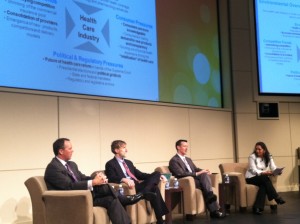I had the pleasure to sit in on a panel discussion at the the 9th Annual SAS Health Care and Life Sciences Executive Conference focused on the topic of understanding and managing customer behavior in the changing health care landscape. This panel was moderated by Dipti Patel-Misra Senior Manager in the Center for Health Analytics & Insights at SAS, and included executives from Blue Cross and Blue Shield of North Carolina, Physicians Pharmacy Alliance and the University of North Carolina at Chapel Hill School of Medicine.
 Many business segments provide services similar to health insurance to consumers on a renewable, annual contract basis. However, the understanding that those other industries have of consumers is different and more advanced compared to a health plan’s understanding of its customers. This panel explored how rising health care costs and consumer value priorities are affecting how health care is sought and provided, and how health plans are looking at new ways to engage with their members to retain them and attract new ones.
Many business segments provide services similar to health insurance to consumers on a renewable, annual contract basis. However, the understanding that those other industries have of consumers is different and more advanced compared to a health plan’s understanding of its customers. This panel explored how rising health care costs and consumer value priorities are affecting how health care is sought and provided, and how health plans are looking at new ways to engage with their members to retain them and attract new ones.
A recurring theme in the sessions at this event is that the individual plays a critical role in any potential "fixes" to spiraling cost of healthcare. Another recurring theme is that technological advances in recent years provide the possibility of harnessing various forms of technology to drive innovation and positive change, including customer analytics among others.
Michael Parkerson from BCBSNC began with an optimistic view of our exciting times in terms of technological innovation as being a potential source of the problems we face in our current healthcare situation.
UNC Healthcare's Dr. Rubinow emphasized the potential of the individual patient as an interested stakeholder in helping shape what the future looks like for healthcare. He proceeded to highlight the new collaboration between BCBSNC and UNC Healthcare, called Carolina Advanced Health, which not coincidentally differentiates itself as being patient-centered. The emphasis at Carolina Advanced Health is on one-stop shopping, access and convenience, self-management and technological support, effective encounters and coordination of care.
Ron Smith from the Physicians Pharmacy Alliance highlighted problems with information and communication as one source of issues. Healthcare information is often incomplete and it's fragmented. Their observations from studying patients with complex medication regimens showed a significant disconnect whereby patients are generally doing what they think they are being asked to do, but they don’t generally understand what they are being asked to do.
The view from the panel is that analytics can play a key role in helping change the system from one where the patients with conditions have to seek the solution providers to one where the solutions are instead provided in ways to meet the patients where they are. Marketers, of course, recognize that kind of talk as "music to our ears." It's all about customer centricity, which is not a simple matter in an industry where the patient as a consumer of healthcare services deals with health insurance companies, healthcare providers, pharmaceutical companies, pharmacies and other entities. Not simple at all, but decidedly necessary and perhaps long overdue.
More broadly, we need to have a cultural change away from the idea that there's a relationship between good quality care and a large number of tests and procedures. Other good nuggets from this panel included:
- A statement that UNC's Dr. Rubinow made that HIPAA has been one of the biggest obstacles imaginable to enabling an integrated healthcare system.
- Social Networking holds great potential to drive desired behaviors and cultural change. Dr. Rubinow highlighted an "offline" example of a boomerang club in Chapel Hill and how its members all had life-altering weight loss experiences.
- Incentive systems can be very powerful at driving healthy behaviors.
Closing thoughts includes the idea that individuals, data, communications and driving understandings with patients are together what holds the most promise for driving positive change. It all comes back to the patient/member /customer. Customer-centricity certainly sounds good to most marketers. What do you think?

2 Comments
Pingback: Treating patients like customers - A Shot in the Arm
Pingback: הובלות